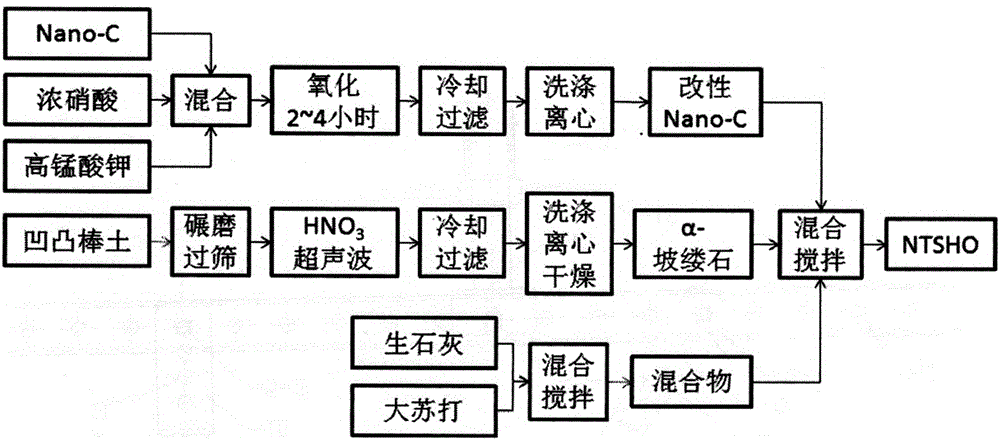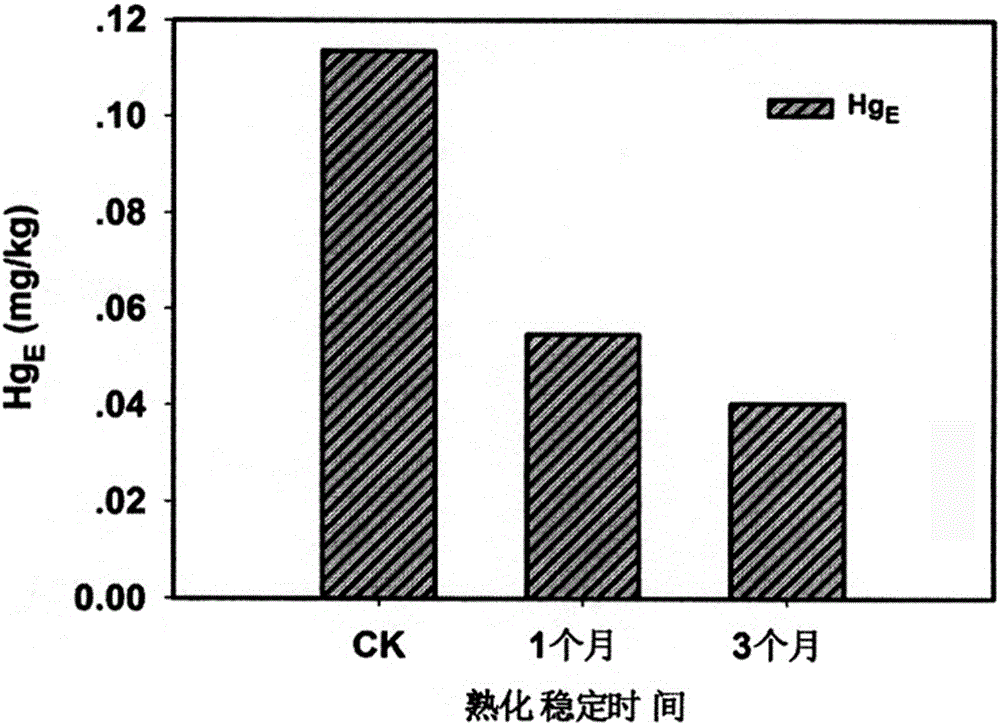Restoration agent for heavy-metal Hg polluted soil, and preparation method and application method thereof
A technology for contaminated soil and remediation agent, applied in the field of quilts, can solve problems such as no reports of soil remediation agents, and achieve the effects of long-lasting remediation effect, simple process flow and quick effect.
- Summary
- Abstract
- Description
- Claims
- Application Information
AI Technical Summary
Problems solved by technology
Method used
Image
Examples
Embodiment 1
[0052] Embodiment 1: the preparation of Hg contaminated soil remediation agent NTSHO new material
[0053] The ratio of parts by mass of the three components in the restoration agent (NTSHO) is: Modified NanoC: α palygorskite: quicklime + sodium bicarbonate mixture = 0.1~15 parts: 5~40 parts: 40~70 parts share.
[0054] The modification and preparation method of the NanoC are as follows:
[0055] a. Mix 16g of NanoC, 22.5mL of concentrated nitric acid with a concentration of 65%, and 80mL of potassium permanganate solution with a concentration of 0.5mol / L according to the ratio of mass parts 1:2:5, let stand and cool;
[0056] b. After the cooling material obtained in step a was left to oxidize at 90° C. for 2 hours, it was centrifugally filtered and cooled.
[0057] c. Repeatedly washing and centrifuging the material obtained in step b with deionized water until the pH value of the supernatant is stable at 6-7.
[0058] d. Dry the material obtained in step c to a constant ...
Embodiment 2
[0065] Example 2: Exploratory research on the optimal dosage of new materials (pot test)
[0066] The remediation agent (NTSHO) prepared in Example 1 was used to explore the optimal dosage of new materials for Hg-contaminated soil, and the effects of multiple remediation agent (NTSHO) addition concentrations on Hg-contaminated soil with different initial concentrations were investigated through pot experiments. The restorative effect, so as to determine the dosage of restorative agent (NTSHO).
[0067] The experimental conditions were set as follows: the initial concentration of Hg in the soil was 8.8 and 19.9ppm respectively; the addition amount (mass fraction) of restoration agent (NTSHO) was 0, 0.1%, 0.2%, 0.3%, 0.4%, 0.5%, respectively. Among the common agricultural products, water spinach has a strong ability to accumulate Hg, and water spinach is one of the most commonly eaten vegetables in polluted sites and surrounding areas. Therefore, water spinach was used as an in...
Embodiment 3
[0083] Example 3: A typical demonstration of new materials used to repair soil in a severely Hg-polluted mining area in Fujian Province
[0084] A typical demonstration of using the remediation agent (NTSHO) in Example 1 to remediate severely Hg-polluted soil in a gold mining area in Fujian Province. The highest initial concentration of Hg in the soil is 79ppm, with an average of 8ppm. According to the conclusion of Example 2, the optimal addition amount of restoration agent (NTSHO) is 0.3% of the soil mass. A typical demonstration mainly examines the effect of different curing times on the restoration effect.
[0085] Typical demonstrations are divided into 3 groups. Group A: control group, no restoration agent added; Group B: addition of 0.3% restoration agent (NTSHO), aging for 1 month; Group C: addition of 0.3% restoration agent (NTSHO), aging for 3 months.
[0086] A typical demonstration restoration process flow chart is as follows: figure 2 As shown, the details are...
PUM
| Property | Measurement | Unit |
|---|---|---|
| specific surface area | aaaaa | aaaaa |
Abstract
Description
Claims
Application Information
 Login to View More
Login to View More - R&D
- Intellectual Property
- Life Sciences
- Materials
- Tech Scout
- Unparalleled Data Quality
- Higher Quality Content
- 60% Fewer Hallucinations
Browse by: Latest US Patents, China's latest patents, Technical Efficacy Thesaurus, Application Domain, Technology Topic, Popular Technical Reports.
© 2025 PatSnap. All rights reserved.Legal|Privacy policy|Modern Slavery Act Transparency Statement|Sitemap|About US| Contact US: help@patsnap.com



